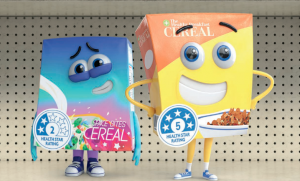Making Healthier Food Choices Part One – Stars
Australia’s health star rating (HSR) system has been in place since 2014 but 73% of stakeholders who provided feedback for the 5-year review said that it has been ineffective at meeting the overall objective of ‘providing convenient, relevant and readily understood nutrition information and/or guidance on food packs to assist consumers to make informed food purchases and healthier choices’. National Heart Foundation (NHF) HSR monitoring surveys indicate that, while prompted awareness of the HSR logo has increased to over 60% since September 2014, the logo is less recognised that six other food logos, unprompted awareness remains low (<15%), and among respondents who were aware of the HSR, just over half were aware that it represents a rating scale of the healthiness of a food product or a comparison between two products in the same category, a decrease from the previous year. This is disheartening at a time when dietary risk factors contribute more than 10% of the burden of disease.
consumers to make informed food purchases and healthier choices’. National Heart Foundation (NHF) HSR monitoring surveys indicate that, while prompted awareness of the HSR logo has increased to over 60% since September 2014, the logo is less recognised that six other food logos, unprompted awareness remains low (<15%), and among respondents who were aware of the HSR, just over half were aware that it represents a rating scale of the healthiness of a food product or a comparison between two products in the same category, a decrease from the previous year. This is disheartening at a time when dietary risk factors contribute more than 10% of the burden of disease.
Why is HSR falling short?
Manufacturers choose which products carry stars
Dr Seuss’ Sylvester McMonkey Mcbean made money putting stars on (and taking stars off) the ‘best kind of Sneetches’. Because HSR is voluntary, food manufacturers can choose which products carry a star and which do not. Thus, profit or a marketing edge may be the reason a particular food carries a star.
Manufactures can label a product based on how it is prepared rather than how it is sold
HSR can mislead consumers if it is calculated on manufacturer recommendations for how the product be consumed. Milo for example, displayed 4.5 stars until public health advocates pointed out that consumers don’t necessarily drink milo as three teaspoons in a cup of skim milk, as recommended by Nestle. Nestle stopped mislabelling the product but other products such as flavour mixes and cordials continued to be mislabelled while the HSR ‘as prepared’ rules were reappraised.
Only packaged foods carry stars
Unlike Australia’s unit pricing strategy, which allows price comparisons of all foods available in supermarkets, shoppers can only compare the healthiness of packaged foods. Even for packaged foods, consumers are limited to comparing 8000 rated items, out of more than 15,000 eligible, and 47,000 available. To be as useful as unit pricing, a health rating system needs to apply to all foods. This would mean stars on shelves as well as on packaging, so that guidance is available for products that are not pre-packaged (e.g. fruit and vegetables, bakery items).
Not all stars are equal
A star on breakfast cereal means something different to a star on milk. This is because, these food items sit in different categories. Breakfast cereals sit in category 2 (all foods other than those included in Category 1 (beverages other than diary), 1D (milk and dairy beverages), 2D (dairy foods other than those in 1D or 3D), 3 (oils and spreads) or 3D (cheese and processed cheese)) while milk sits in category 1D. The categories exist for a range of valid reasons, including allowing the underlying algorithm to distinguish between naturally occurring and added sugars. Regardless of why the categories exist however, NHF surveys indicate that they trip most consumers up. In November 2017, 55% of 2,531 households surveyed reported that HSR makes it easier for them to identify healthier options across different categories, which it is not designed to do.
Stars give a health halo to packaged food
The health star ratings range from half a star (little or no nutritious value) to five stars (a healthier choice). The use of stars coupled with the issues outlined above, give consumers a false sense of how healthy a product is. For example, a one-star product may be perceived as healthy, just less healthy than a product with two or more stars. In the most recent NHF survey, only 53% stated that food products with one star had little or no nutritious value. The same survey found that 89% interpreted five stars to mean the product is the healthiest choice and good for their health. This is a ‘best of a bad lot’ scenario however because consumers are choosing from a limited range of food items using a labelling scheme that has variation in the way it is applied. One study concluded that HSR system undermines Australian Dietary Guideline recommendations by facilitating marketing of discretionary foods and proposes major reforms.
Clearer and more effective nutrition guidance
Australian consumers need clearer and more effective guidance for choosing healthy foods.
Pr![]() of Colin Bell’s research is focused on making healthy choices easy choices. Stay tuned for Making Healthier Food Choices Part Two – Stop Signs.
of Colin Bell’s research is focused on making healthy choices easy choices. Stay tuned for Making Healthier Food Choices Part Two – Stop Signs.